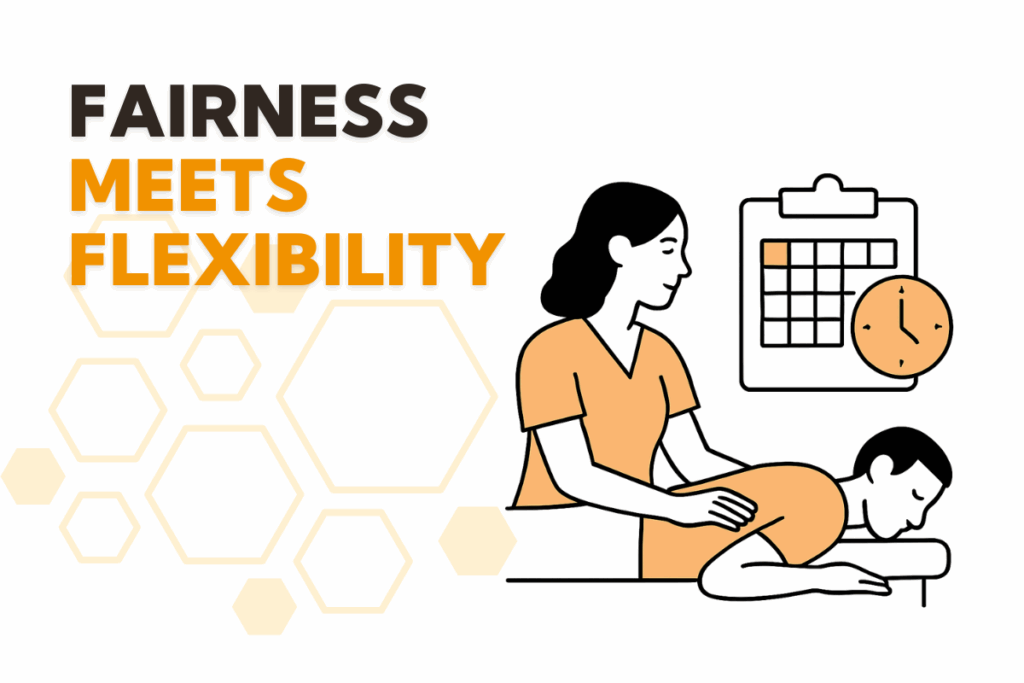Learn how to manage therapist scheduling preferences with structure, fairness, and clarity in your massage clinic.
Managing therapist scheduling preferences is one of the most overlooked yet consistently challenging responsibilities for massage clinic owners. At first glance, it might seem like a straightforward task—just matching therapist availability with client bookings. But in practice, it’s a complex balancing act that touches every part of your business. Aligning individual preferences with client demand, treatment room usage, and revenue goals quickly turns your calendar into a moving puzzle.
Without a clear structure, managing these preferences drains your time, fragments your focus, and creates confusion for your team and your clients. Over time, small scheduling compromises can build into bigger issues that affect therapist satisfaction, client retention, and overall clinic performance. Creating a system that respects therapist needs while supporting your business goals is essential for long-term sustainability.
Therapist Scheduling Preferences Can Derail Even the Best-Run Clinics
Custom scheduling comes with hidden costs
What starts as a few availability requests—no weekends, no mornings, only certain clients—quickly turns into a full-time job of managing therapist scheduling preferences. Your front desk is overwhelmed. Clients can’t easily rebook. And you’re constantly rearranging shifts to meet everyone’s needs except your own.
Your business needs get lost in the shuffle
When therapist preferences take priority over client demand, the result is often a loss of revenue, unpredictable booking flow, and growing tension. Instead of consistent operations, you’re running a clinic with constantly shifting pieces.
You carry the emotional weight of every decision
Saying yes feels supportive. Saying no feels risky. Managing therapist scheduling preferences isn’t just a logistical issue—it’s personal. And over time, it becomes draining to navigate the needs of your team while trying to protect the business you’ve worked hard to build.

Most Scheduling Issues Stem From a Lack of Structure
A reactive approach creates more problems
If your current method of managing therapist scheduling preferences is to handle each request as it comes in, you’re setting yourself up for long-term stress. Without a clear system, small exceptions start to affect the entire team—and the client experience.
When there are no shared rules, therapists make their own
Therapists often block off time, reject certain services, or adjust their schedules without much warning. These aren’t signs of disrespect—they’re symptoms of unclear expectations. The absence of a system leaves too much room for misalignment.
Feedback only shows up when something breaks
You’ll hear about scheduling frustrations when they’ve already caused a problem. Whether it’s a missed shift, a client complaint, or internal friction, managing therapist scheduling preferences needs to be proactive, not reactive.
How to Set a Strong Framework for Managing Therapist Scheduling Preferences
Define the clinic’s scheduling priorities first
Clarify what hours and coverage are essential to meet client demand. Identify your busiest time slots, your most requested services, and the number of therapists required each day. These benchmarks anchor your entire schedule.
Invite therapist preferences through structured input
Rather than handling availability changes in real time, ask therapists to submit their preferences quarterly. Allow them to note unavailable days and rank preferred shifts. This creates a sense of ownership without disrupting your core calendar.
Use rotating shifts to maintain fairness
Not everyone wants weekends or evenings. A rotating schedule helps spread those shifts evenly across your team. Therapists feel seen, and the clinic maintains reliable coverage during peak hours.
Revisit schedules every quarter to stay aligned
Scheduling needs change. Whether it’s personal life updates or business growth, quarterly reviews give you a rhythm to address changes without constant adjustment. This ongoing structure makes managing therapist scheduling preferences easier over time.
Use a centralized system for shared visibility
Having a real-time calendar that the entire team can access reduces confusion and double bookings. With online appointment scheduling for massage clinics, therapists, front desk staff, and owners stay on the same page.
What Fair and Flexible Scheduling Can Look Like
Combine core hours with flexible days
One clinic created a schedule with Tuesday through Friday as core days, staffed by all therapists. Mondays and Saturdays rotated monthly. Each therapist submitted availability ahead of time. This reduced scheduling conflicts and improved therapist retention.
Build in time for therapist recovery
Managing therapist scheduling preferences also means recognizing the physical toll of hands-on work. One team added 15-minute breaks after every third session, improving documentation and energy levels without reducing daily appointments.

Systems That Support Better Scheduling
Choose tools that make scheduling transparent and simple
Scheduling software should include therapist-level availability, shift reminders, and the ability to approve or decline changes with ease. Automated business tools for massage clinics help clinic owners reduce time spent on repetitive tasks and avoid miscommunication.
Create a clear process for submitting requests
Instead of hallway conversations or late-night texts, offer a simple digital form for shift changes or time-off requests. This standardizes the process and reduces stress for both owners and staff.
Talk about scheduling early and often
Monthly scheduling meetings give space to discuss concerns before they become complaints. Framing these conversations around care, sustainability, and teamwork helps therapists stay open and involved in the process.
Managing Therapist Scheduling Preferences Without Losing Your Mind
Managing therapist scheduling preferences doesn’t have to mean saying yes to everything or feeling like you’re always playing catch-up. With structure, shared understanding, and regular check-ins, you can build a schedule that works for your team and your clinic.
The key is clarity. When everyone understands the goals, boundaries, and expectations around scheduling, it creates space for flexibility without chaos. You can protect your business, support your therapists, and create a stronger, more sustainable rhythm in your clinic.
Inside The Hivecommunity, we’re working on this together—sharing real solutions, clear frameworks, and templates that help reduce stress and build connection. If you’re ready to stop managing therapist scheduling preferences alone, you’re in the right place.
Frequently Asked Questions
Start by identifying your clinic’s peak hours and required coverage. Build schedules around those anchors, then layer in therapist preferences where possible. Keep the business needs visible to everyone involved.
A monthly or quarterly schedule works well for most clinics. Provide therapists with clear deadlines for submitting preferences and finalize schedules at least two weeks in advance to avoid last-minute changes.
Be transparent. Acknowledge their preference, explain why the request isn’t feasible, and offer an alternative if possible. Framing it around client care and clinic consistency helps keep the tone supportive.
Communicate early. Share the “why” behind the change, involve the team in shaping the process, and allow time for feedback. Emphasize how the new structure supports both therapist wellbeing and client service.



